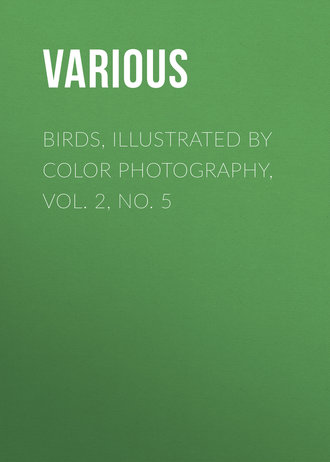 полная версия
полная версияBirds, Illustrated by Color Photography, Vol. 2, No. 5
Nest – Depression in the sand without lining.
Eggs – Four, light gray to creamy buff, finely speckled with blackish brown and purplish gray.
Page 180.
WILD TURKEY—Meleagris gallopava.
Range – Eastern United States from Pennsylvania southward to Florida, west to Wisconsin, the Indian Territory and Texas.
Nest – On the ground, at the base of a bush or tree.
Eggs – Ten to fourteen, pale cream buff, finely and evenly speckled with grayish brown.
Page 181.
CERULEAN WARBLER—Dendræca caerulea. Other names: “Azure Warbler;” “White-throated Blue Warbler.”
Range – Mississippi valley as far north as Minnesota, and eastward as far as Lockport, N. Y. (Davison.) Winters in the tropics.
Nest – Of fine grasses bound with spider’s silk, lined with strips of bark and with a few lichens attached to its upper surface, in a tree, twenty-five to fifty feet from the ground. (Chapman.)
Eggs – Four, creamy-white, thickly covered with rather heavy blotches of reddish brown.
Page 186.
YELLOW-BILLED TROPIC BIRD.—Phaethon flavirostris. Other names: “Phaeton.”
Range. – Tropical coasts; Atlantic coasts of tropical America, West Indies, Bahamas, Bermudas; casual in Florida and accidental in Western New York and Nova Scotia. (Chapman.)
Nest – In holes in the perpendicular faces of cliffs, also on the flat surfaces of rocks.
Eggs – One, ground color of purplish brownish white, covered with fine reddish chocolate-colored spots. (Davie.)
Page 190.
EUROPEAN KINGFISHER.—Alcedo ispida.
Range – England and portions of Europe.
Nest – In holes of the banks of streams.
Eggs – Usually six, of a deep pinkish hue.
Page 193.
VERMILION FLY-CATCHER.—Pyocephalus rubineus mexicanus.
Range – Southern Border of the United States south through Mexico and Guatemala.
Nest – In forks of ratana trees, not more than six feet up, of small twigs and soft materials felted together, the rims covered with lichens; the cavity is shallow.
Eggs – Usually three, the ground color a rich creamy-white, with a ring of large brown and lilac blotches at the larger end.
Page 198.
LAZULI BUNTING.—Passerina amoena. Other name: “Lazuli Painted Finch.”
Range – Western United States from the Great Plains to the Pacific; south in winter to Western Mexico.
Nest – In a bush or the lower limbs of trees, a few feet from the ground, of fine strips of bark, small twigs, grasses, and is lined with hair.
Eggs – Usually four, light bluish-green.









